Ảnh hưởng của việc trình bày sản phẩm trực tuyến đến việc gợi nhớ sản phẩm: Vai trò điều chỉnh của loại sản phẩm
Trình bày sản phẩm trực tuyến là một tính năng không thể thiếu trong mua sắm trực tuyến
nhằm tạo điều kiện thuận lợi cho quá trình mua hàng của người tiêu dùng thông qua cách cung
cấp thông tin sản phẩm. Nghiên cứu này áp dụng lý thuyết xử lý thông tin nhận thức để tìm hiểu tác
động của việc trình bày sản phẩm trực tuyến đối với việc gợi nhớ sản phẩm được điều chỉnh theo
loại sản phẩm. Thí nghiệm được thiết kế gồm 4 tình huống kết hợp giữa các biến được nghiên cứu
được điều chỉnh bao gồm trình bày văn bản so với video và sản phẩm giải trí so với sản phẩm thực
dụng. Phân tích MANCOVA và ANCOVA sẽ được sử dụng để kiểm tra các giả thuyết. Kết quả của
nghiên cứu này mang lại lợi ích nhà tiếp thị để phát triển các chiến lược phù hợp về trình bày sản
phẩm và nâng cao hiệu quả quảng cáo.
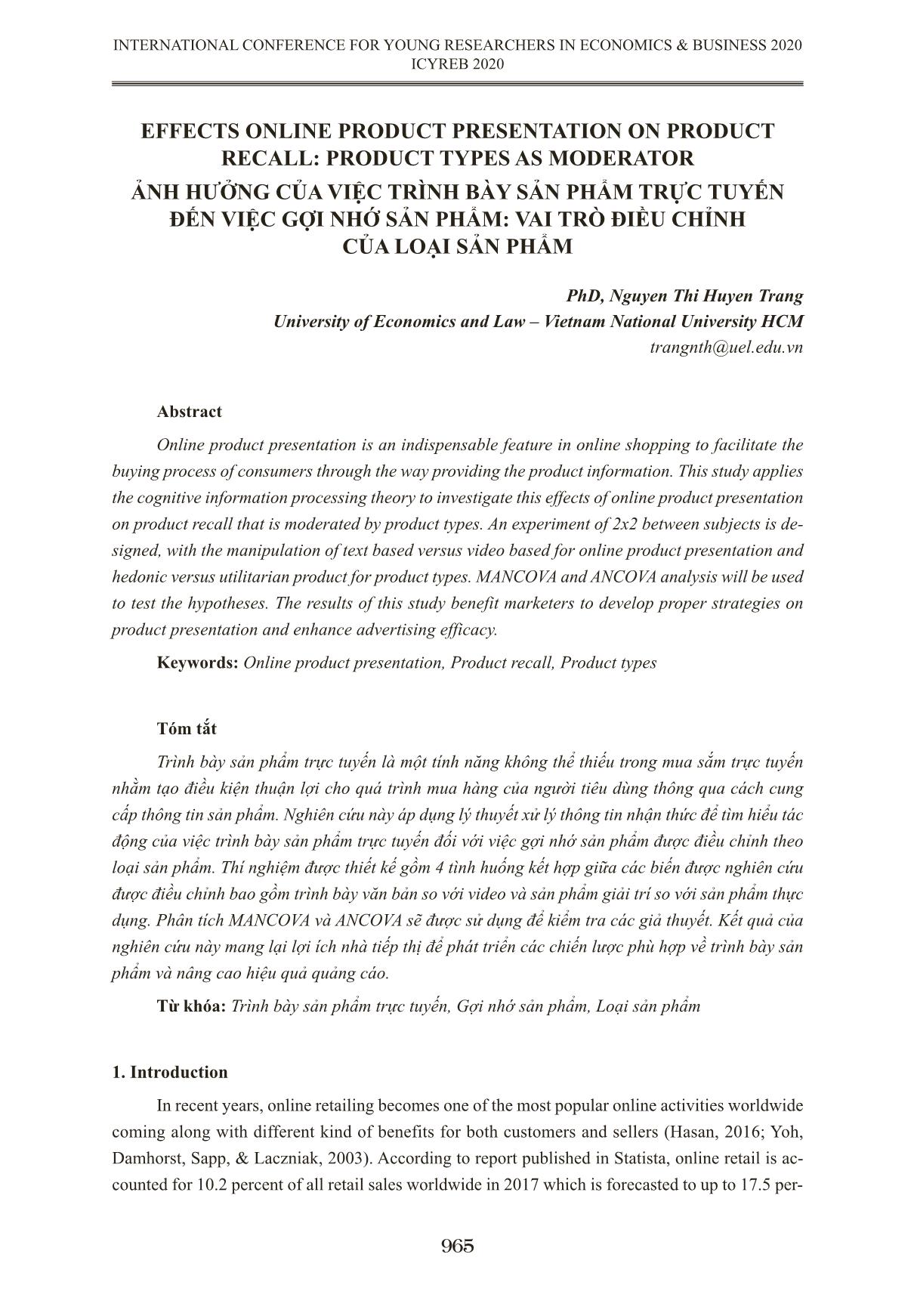
Trang 1
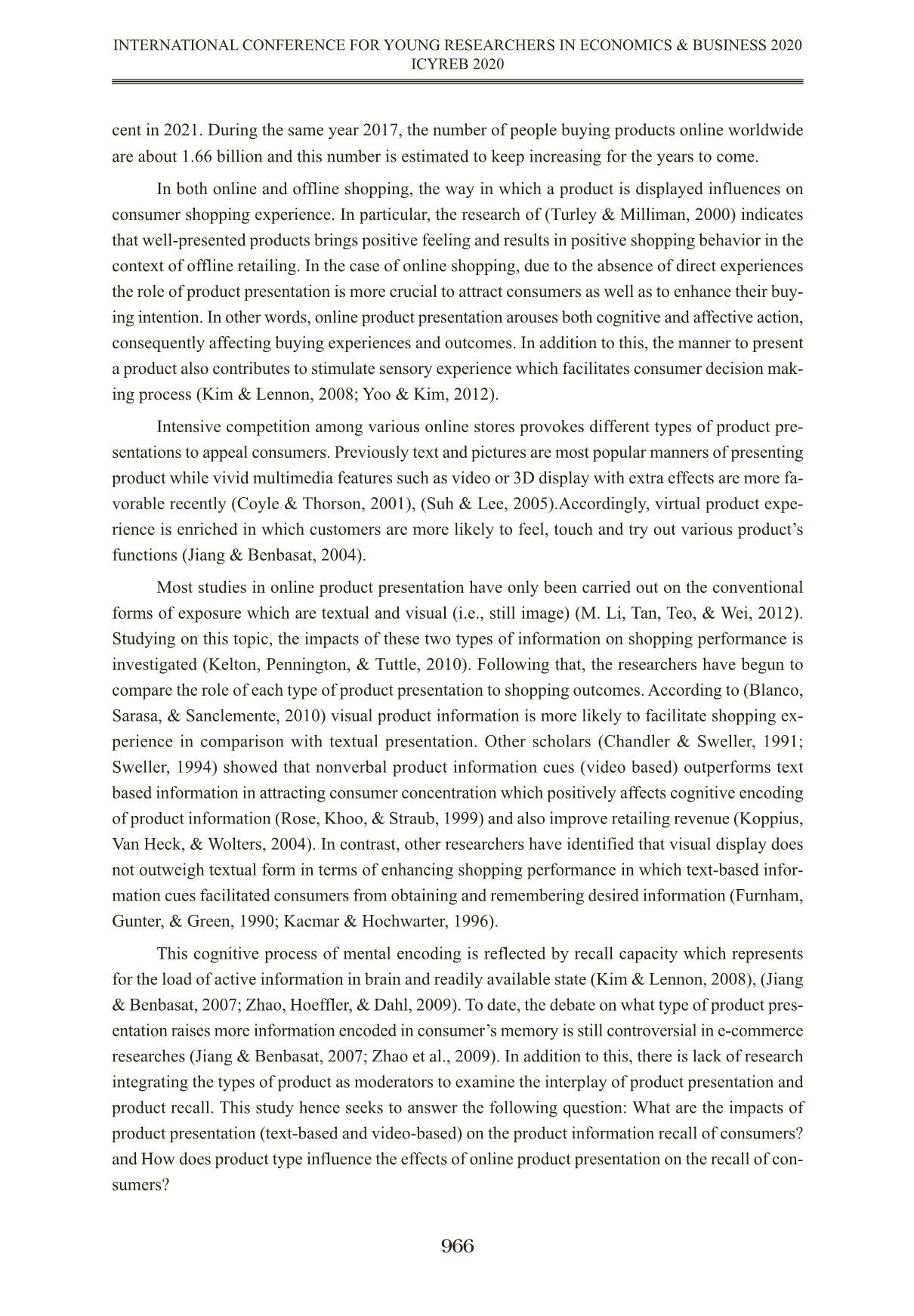
Trang 2
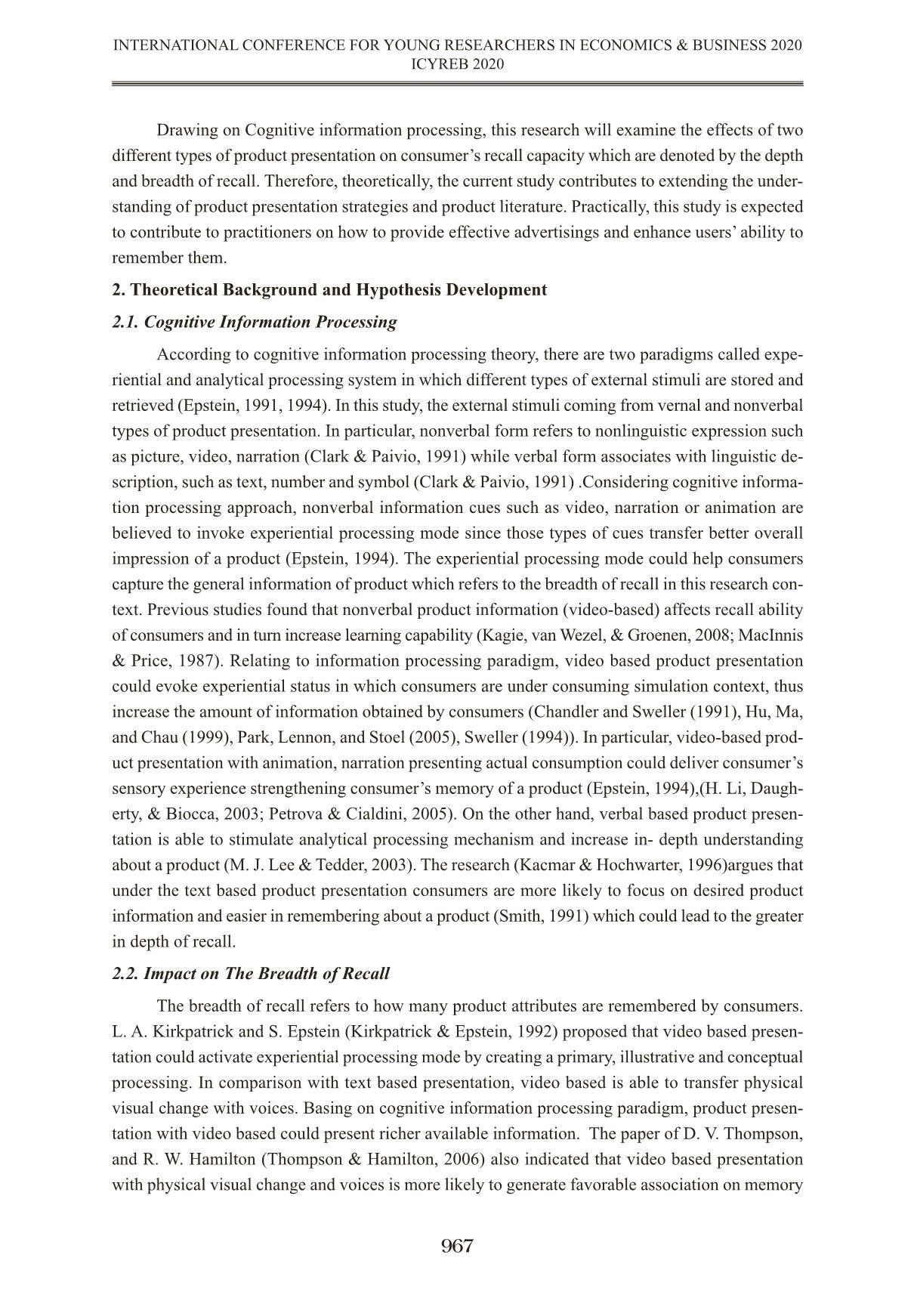
Trang 3
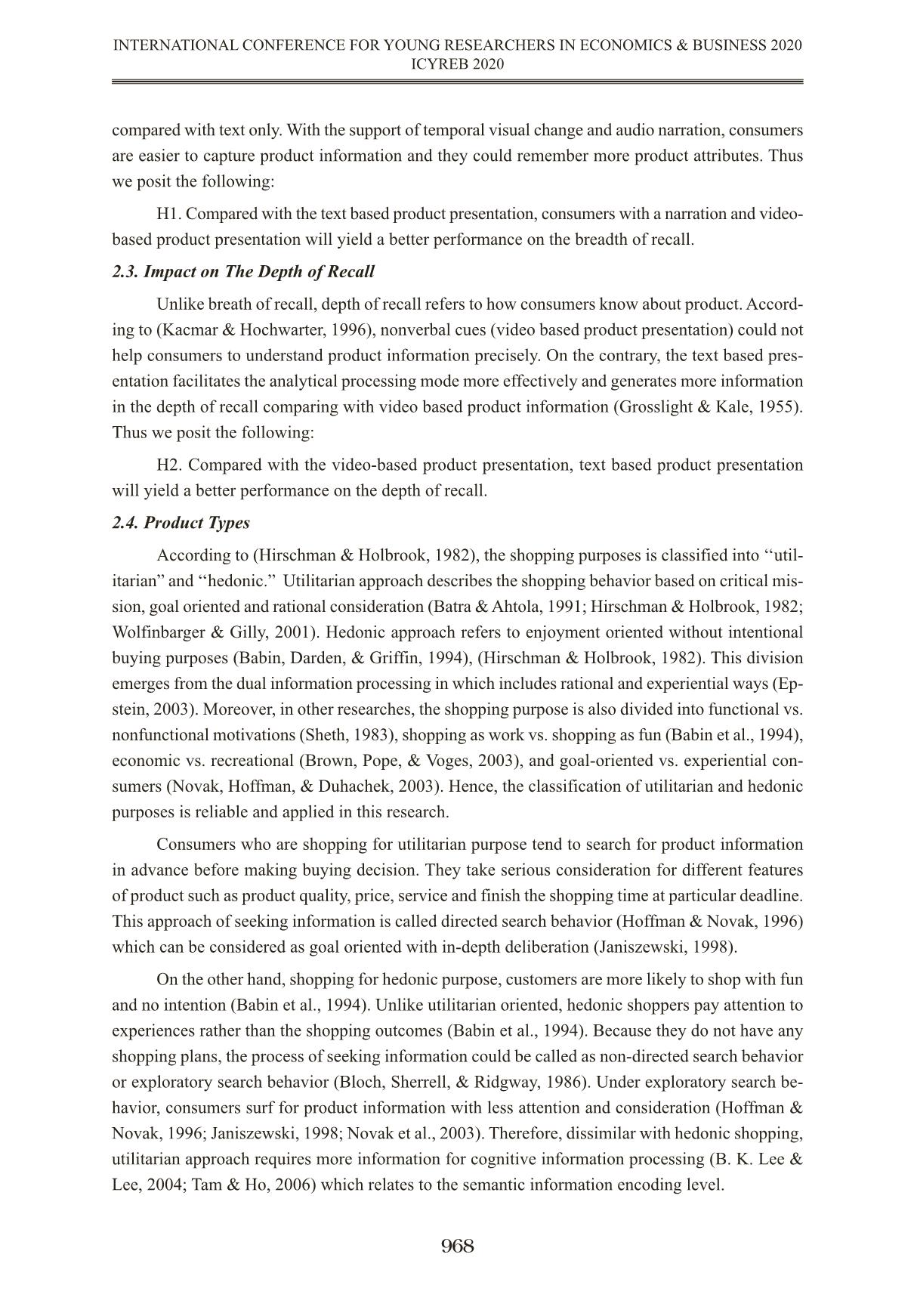
Trang 4
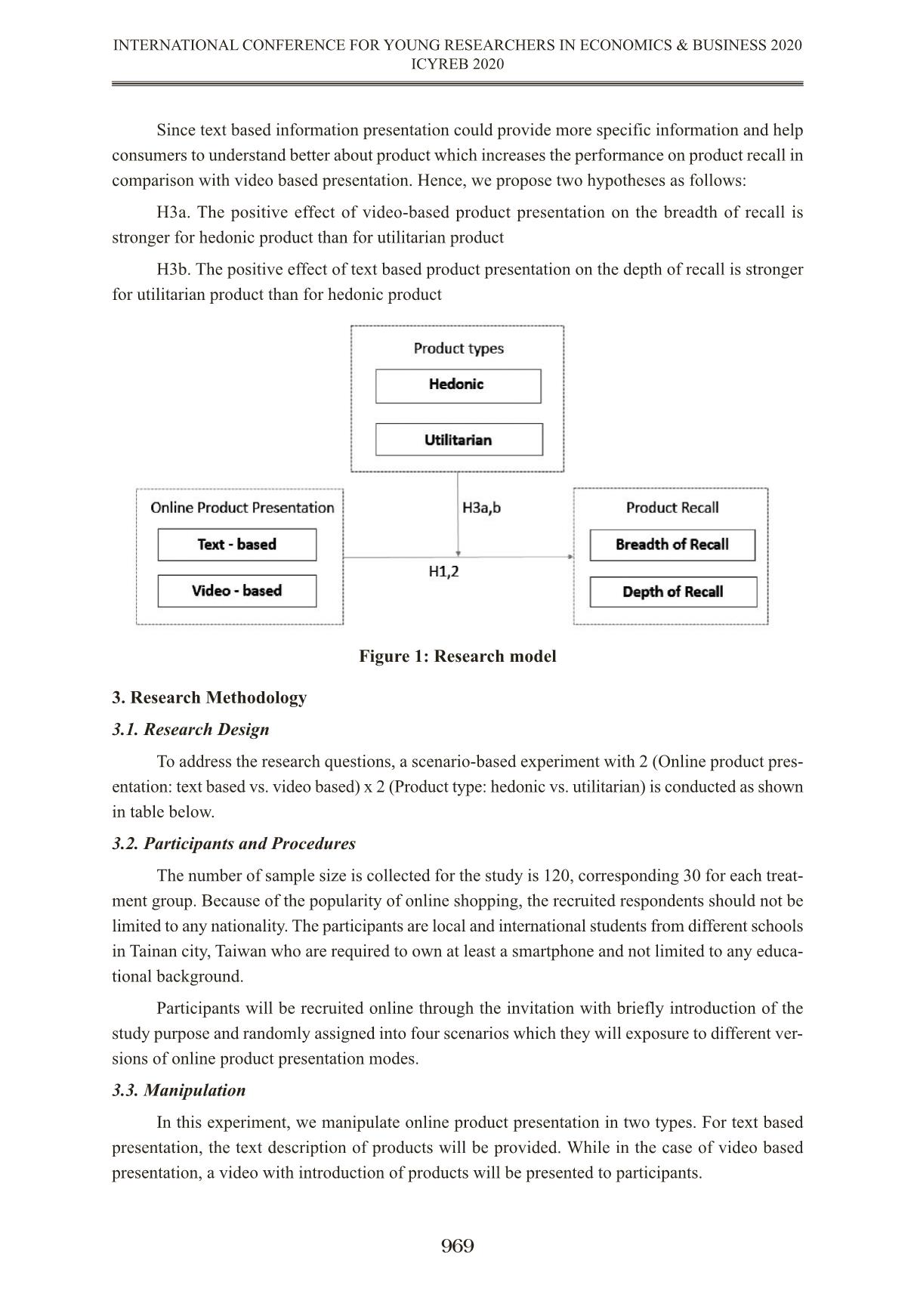
Trang 5
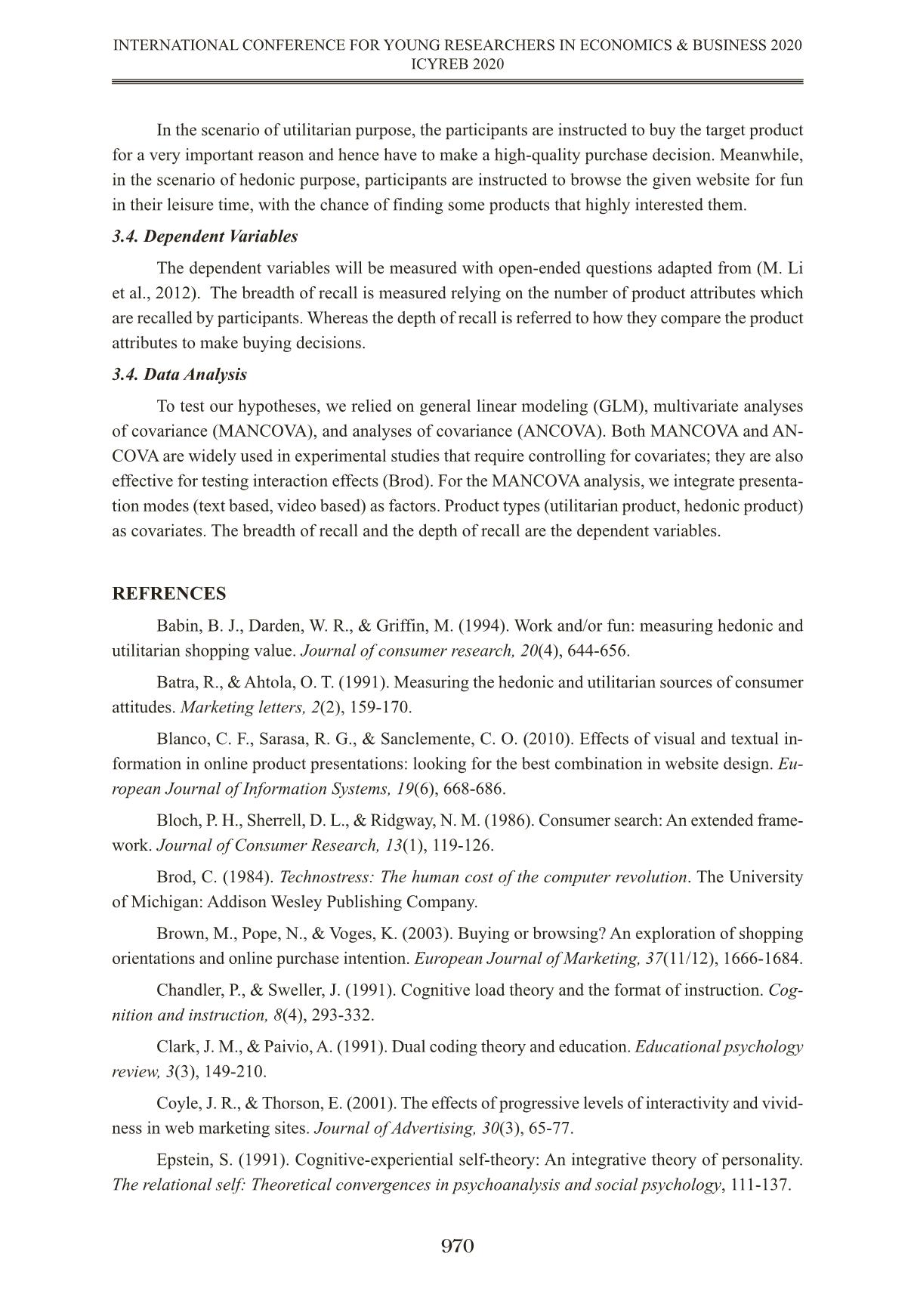
Trang 6
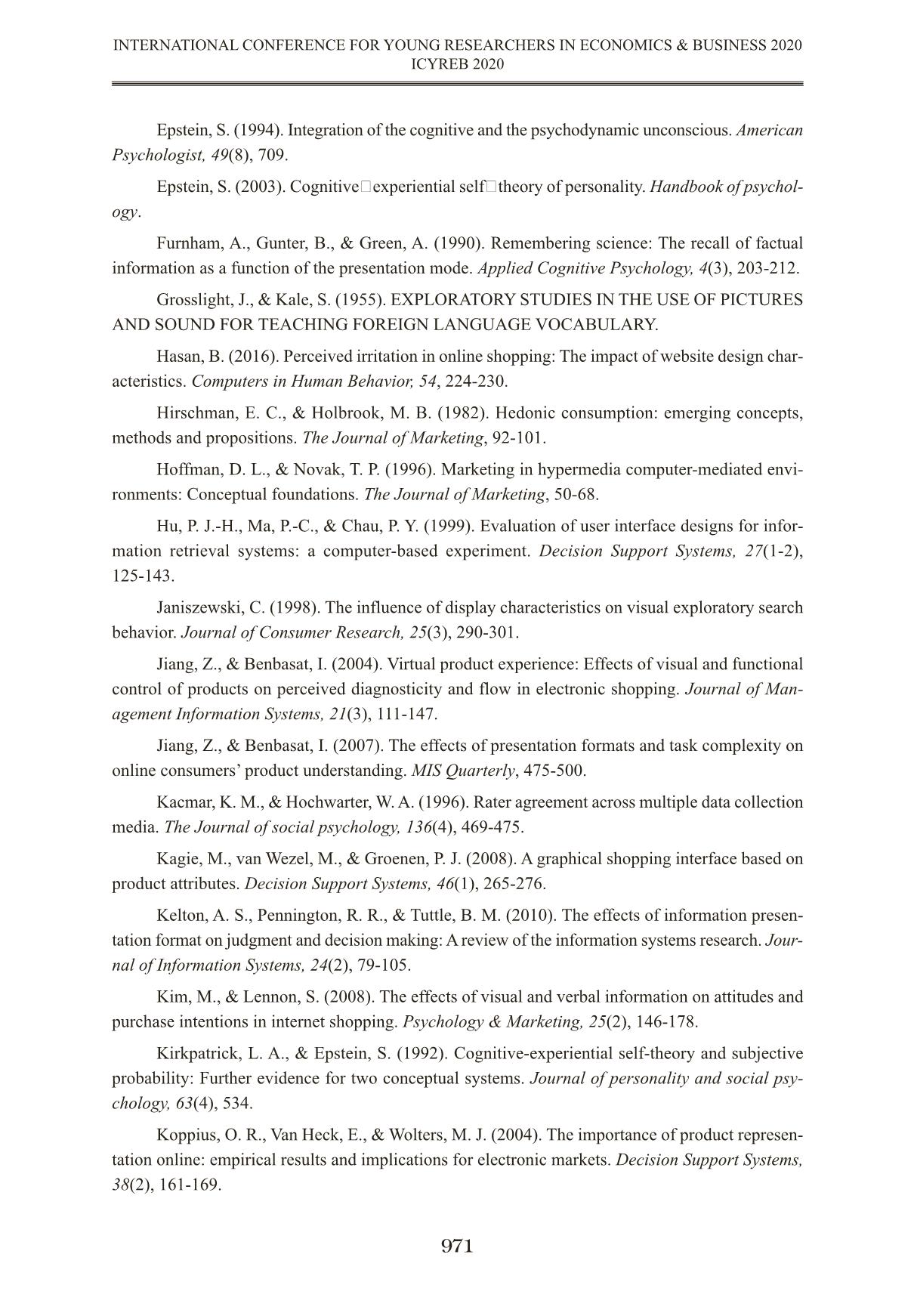
Trang 7
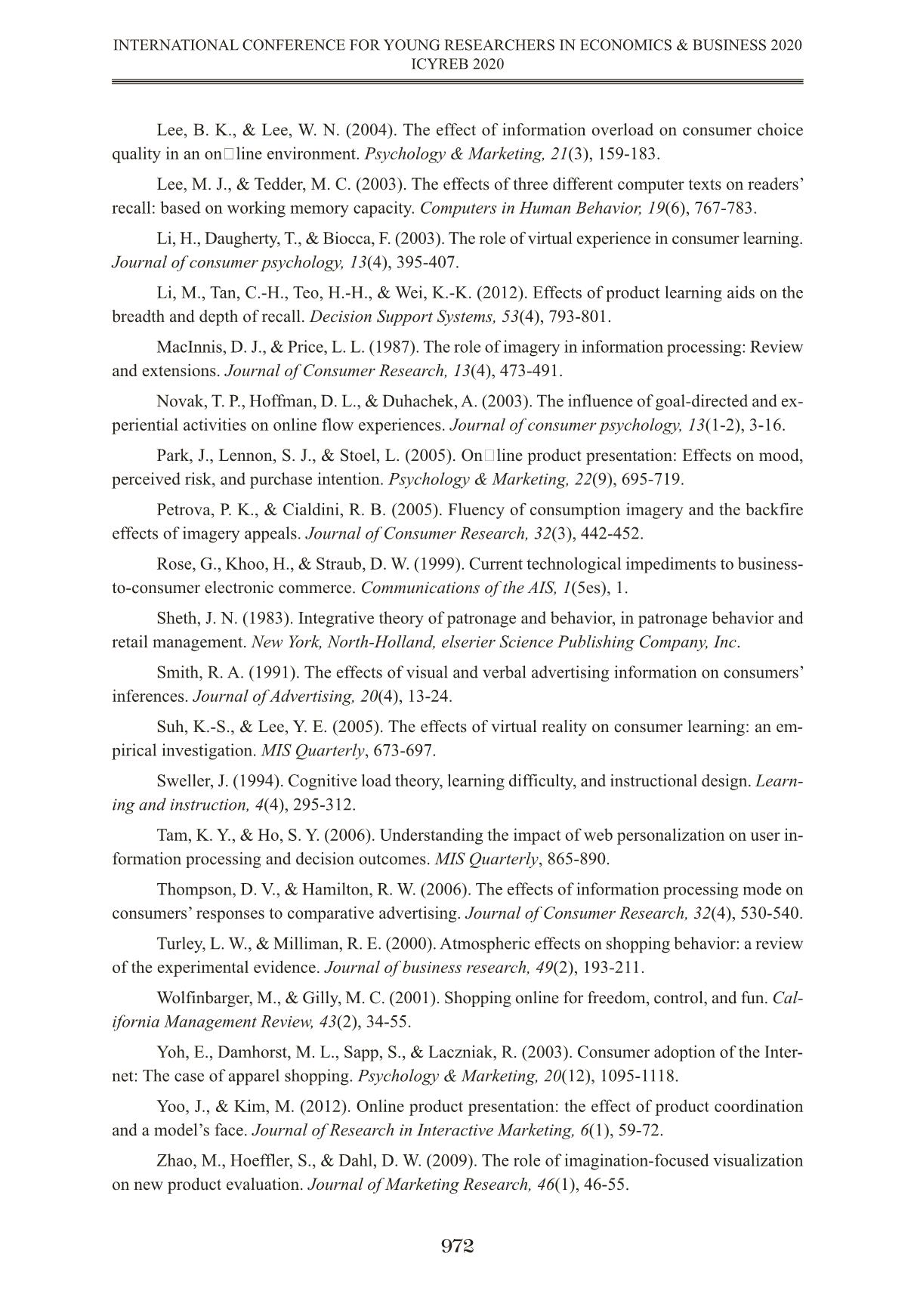
Trang 8
Tóm tắt nội dung tài liệu: Ảnh hưởng của việc trình bày sản phẩm trực tuyến đến việc gợi nhớ sản phẩm: Vai trò điều chỉnh của loại sản phẩm
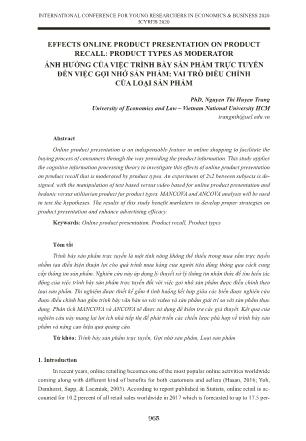
EFFECTS ONLINE PRODUCT PRESENTATION ON PRODUCT RECALL: PRODUCT TYPES AS MODERATOR ẢNH HƯỞNG CỦA VIỆC TRÌNH BÀY SẢN PHẨM TRỰC TUYẾN ĐẾN VIỆC GỢI NHỚ SẢN PHẨM: VAI TRÒ ĐIỀU CHỈNH CỦA LOẠI SẢN PHẨM PhD, Nguyen Thi Huyen Trang University of Economics and Law – Vietnam National University HCM trangnth@uel.edu.vn Abstract Online product presentation is an indispensable feature in online shopping to facilitate the buying process of consumers through the way providing the product information. This study applies the cognitive information processing theory to investigate this effects of online product presentation on product recall that is moderated by product types. An experiment of 2x2 between subjects is de- signed, with the manipulation of text based versus video based for online product presentation and hedonic versus utilitarian product for product types. MANCOVA and ANCOVA analysis will be used to test the hypotheses. The results of this study benefit marketers to develop proper strategies on product presentation and enhance advertising efficacy. Keywords: Online product presentation, Product recall, Product types Tóm tắt Trình bày sản phẩm trực tuyến là một tính năng không thể thiếu trong mua sắm trực tuyến nhằm tạo điều kiện thuận lợi cho quá trình mua hàng của người tiêu dùng thông qua cách cung cấp thông tin sản phẩm. Nghiên cứu này áp dụng lý thuyết xử lý thông tin nhận thức để tìm hiểu tác động của việc trình bày sản phẩm trực tuyến đối với việc gợi nhớ sản phẩm được điều chỉnh theo loại sản phẩm. Thí nghiệm được thiết kế gồm 4 tình huống kết hợp giữa các biến được nghiên cứu được điều chỉnh bao gồm trình bày văn bản so với video và sản phẩm giải trí so với sản phẩm thực dụng. Phân tích MANCOVA và ANCOVA sẽ được sử dụng để kiểm tra các giả thuyết. Kết quả của nghiên cứu này mang lại lợi ích nhà tiếp thị để phát triển các chiến lược phù hợp về trình bày sản phẩm và nâng cao hiệu quả quảng cáo. Từ khóa: Trình bày sản phẩm trực tuyến, Gợi nhớ sản phẩm, Loại sản phẩm 1. Introduction In recent years, online retailing becomes one of the most popular online activities worldwide coming along with different kind of benefits for both customers and sellers (Hasan, 2016; Yoh, Damhorst, Sapp, & Laczniak, 2003). According to report published in Statista, online retail is ac- counted for 10.2 percent of all retail sales worldwide in 2017 which is forecasted to up to 17.5 per- 965 INTERNATIONAL CONFERENCE FOR YOUNG RESEARCHERS IN ECONOMICS & BUSINESS 2020 ICYREB 2020 cent in 2021. During the same year 2017, the number of people buying products online worldwide are about 1.66 billion and this number is estimated to keep increasing for the years to come. In both online and offline shopping, the way in which a product is displayed influences on consumer shopping experience. In particular, the research of (Turley & Milliman, 2000) indicates that well-presented products brings positive feeling and results in positive shopping behavior in the context of offline retailing. In the case of online shopping, due to the absence of direct experiences the role of product presentation is more crucial to attract consumers as well as to enhance their buy- ing intention. In other words, online product presentation arouses both cognitive and affective action, consequently affecting buying experiences and outcomes. In addition to this, the manner to present a product also contributes to stimulate sensory experience which facilitates consumer decision mak- ing process (Kim & Lennon, 2008; Yoo & Kim, 2012). Intensive competition among various online stores provokes different types of product pre- sentations to appeal consumers. Previously text and pictures are most popular manners of presenting product while vivid multimedia features such as video or 3D display with extra effects are more fa- vorable recently (Coyle & Thorson, 2001), (Suh & Lee, 2005).Accordingly, virtual product expe- rience is enriched in which customers are more likely to feel, touch and try out various product’s functions (Jiang & Benbasat, 2004). Most studies in online product presentation have only been carried out on the conventional forms of exposure which are textual and visual (i.e., still image) (M. Li, Tan, Teo, & Wei, 2012). Studying on this topic, the impacts of these two types of information on shopping performance is investigated (Kelton, Pennington, & Tuttle, 2010). Following that, the researchers have begun to compare the role of each type of product presentation to shopping outcomes. According to (Blanco, Sarasa, & Sanclemente, 2010) visual product information is more likely to facilitate shopping ex- perience in comparison with textual presentation. Other scholars (Chandler & Sweller, 1991; Sweller, 1994) showed that nonverbal product information cues (video based) outperforms text based information in attracting consumer concentration which positively affects cognitive encoding of product ... pport of temporal visual change and audio narration, consumers are easier to capture product information and they could remember more product attributes. Thus we posit the following: H1. Compared with the text based product presentation, consumers with a narration and video- based product presentation will yield a better performance on the breadth of recall. 2.3. Impact on The Depth of Recall Unlike breath of recall, depth of recall refers to how consumers know about product. Accord- ing to (Kacmar & Hochwarter, 1996), nonverbal cues (video based product presentation) could not help consumers to understand product information precisely. On the contrary, the text based pres- entation facilitates the analytical processing mode more effectively and generates more information in the depth of recall comparing with video based product information (Grosslight & Kale, 1955). Thus we posit the following: H2. Compared with the video-based product presentation, text based product presentation will yield a better performance on the depth of recall. 2.4. Product Types According to (Hirschman & Holbrook, 1982), the shopping purposes is classified into ‘‘util- itarian” and ‘‘hedonic.” Utilitarian approach describes the shopping behavior based on critical mis- sion, goal oriented and rational consideration (Batra & Ahtola, 1991; Hirschman & Holbrook, 1982; Wolfinbarger & Gilly, 2001). Hedonic approach refers to enjoyment oriented without intentional buying purposes (Babin, Darden, & Griffin, 1994), (Hirschman & Holbrook, 1982). This division emerges from the dual information processing in which includes rational and experiential ways (Ep- stein, 2003). Moreover, in other researches, the shopping purpose is also divided into functional vs. nonfunctional motivations (Sheth, 1983), shopping as work vs. shopping as fun (Babin et al., 1994), economic vs. recreational (Brown, Pope, & Voges, 2003), and goal-oriented vs. experiential con- sumers (Novak, Hoffman, & Duhachek, 2003). Hence, the classification of utilitarian and hedonic purposes is reliable and applied in this research. Consumers who are shopping for utilitarian purpose tend to search for product information in advance before making buying decision. They take serious consideration for different features of product such as product quality, price, service and finish the shopping time at particular deadline. This approach of seeking information is called directed search behavior (Hoffman & Novak, 1996) which can be considered as goal oriented with in-depth deliberation (Janiszewski, 1998). On the other hand, shopping for hedonic purpose, customers are more likely to shop with fun and no intention (Babin et al., 1994). Unlike utilitarian oriented, hedonic shoppers pay attention to experiences rather than the shopping outcomes (Babin et al., 1994). Because they do not have any shopping plans, the process of seeking information could be called as non-directed search behavior or exploratory search behavior (Bloch, Sherrell, & Ridgway, 1986). Under exploratory search be- havior, consumers surf for product information with less attention and consideration (Hoffman & Novak, 1996; Janiszewski, 1998; Novak et al., 2003). Therefore, dissimilar with hedonic shopping, utilitarian approach requires more information for cognitive information processing (B. K. Lee & Lee, 2004; Tam & Ho, 2006) which relates to the semantic information encoding level. 968 INTERNATIONAL CONFERENCE FOR YOUNG RESEARCHERS IN ECONOMICS & BUSINESS 2020 ICYREB 2020 Since text based information presentation could provide more specific information and help consumers to understand better about product which increases the performance on product recall in comparison with video based presentation. Hence, we propose two hypotheses as follows: H3a. The positive effect of video-based product presentation on the breadth of recall is stronger for hedonic product than for utilitarian product H3b. The positive effect of text based product presentation on the depth of recall is stronger for utilitarian product than for hedonic product Figure 1: Research model 3. Research Methodology 3.1. Research Design To address the research questions, a scenario-based experiment with 2 (Online product pres- entation: text based vs. video based) x 2 (Product type: hedonic vs. utilitarian) is conducted as shown in table below. 3.2. Participants and Procedures The number of sample size is collected for the study is 120, corresponding 30 for each treat- ment group. Because of the popularity of online shopping, the recruited respondents should not be limited to any nationality. The participants are local and international students from different schools in Tainan city, Taiwan who are required to own at least a smartphone and not limited to any educa- tional background. Participants will be recruited online through the invitation with briefly introduction of the study purpose and randomly assigned into four scenarios which they will exposure to different ver- sions of online product presentation modes. 3.3. Manipulation In this experiment, we manipulate online product presentation in two types. For text based presentation, the text description of products will be provided. While in the case of video based presentation, a video with introduction of products will be presented to participants. 969 INTERNATIONAL CONFERENCE FOR YOUNG RESEARCHERS IN ECONOMICS & BUSINESS 2020 ICYREB 2020 In the scenario of utilitarian purpose, the participants are instructed to buy the target product for a very important reason and hence have to make a high-quality purchase decision. Meanwhile, in the scenario of hedonic purpose, participants are instructed to browse the given website for fun in their leisure time, with the chance of finding some products that highly interested them. 3.4. Dependent Variables The dependent variables will be measured with open-ended questions adapted from (M. Li et al., 2012). The breadth of recall is measured relying on the number of product attributes which are recalled by participants. Whereas the depth of recall is referred to how they compare the product attributes to make buying decisions. 3.4. Data Analysis To test our hypotheses, we relied on general linear modeling (GLM), multivariate analyses of covariance (MANCOVA), and analyses of covariance (ANCOVA). Both MANCOVA and AN- COVA are widely used in experimental studies that require controlling for covariates; they are also effective for testing interaction effects (Brod). For the MANCOVA analysis, we integrate presenta- tion modes (text based, video based) as factors. Product types (utilitarian product, hedonic product) as covariates. The breadth of recall and the depth of recall are the dependent variables. REFRENCES Babin, B. J., Darden, W. R., & Griffin, M. (1994). Work and/or fun: measuring hedonic and utilitarian shopping value. Journal of consumer research, 20(4), 644-656. Batra, R., & Ahtola, O. T. (1991). Measuring the hedonic and utilitarian sources of consumer attitudes. Marketing letters, 2(2), 159-170. Blanco, C. F., Sarasa, R. G., & Sanclemente, C. O. (2010). Effects of visual and textual in- formation in online product presentations: looking for the best combination in website design. Eu- ropean Journal of Information Systems, 19(6), 668-686. Bloch, P. H., Sherrell, D. L., & Ridgway, N. M. (1986). Consumer search: An extended frame- work. Journal of Consumer Research, 13(1), 119-126. Brod, C. (1984). Technostress: The human cost of the computer revolution. The University of Michigan: Addison Wesley Publishing Company. Brown, M., Pope, N., & Voges, K. (2003). Buying or browsing? An exploration of shopping orientations and online purchase intention. European Journal of Marketing, 37(11/12), 1666-1684. Chandler, P., & Sweller, J. (1991). Cognitive load theory and the format of instruction. Cog- nition and instruction, 8(4), 293-332. Clark, J. M., & Paivio, A. (1991). Dual coding theory and education. Educational psychology review, 3(3), 149-210. Coyle, J. R., & Thorson, E. (2001). The effects of progressive levels of interactivity and vivid- ness in web marketing sites. Journal of Advertising, 30(3), 65-77. Epstein, S. (1991). Cognitive-experiential self-theory: An integrative theory of personality. The relational self: Theoretical convergences in psychoanalysis and social psychology, 111-137. 970 INTERNATIONAL CONFERENCE FOR YOUNG RESEARCHERS IN ECONOMICS & BUSINESS 2020 ICYREB 2020 Epstein, S. (1994). Integration of the cognitive and the psychodynamic unconscious. American Psychologist, 49(8), 709. Epstein, S. (2003). Cognitiveexperiential self theory of personality. Handbook of psychol- ogy. Furnham, A., Gunter, B., & Green, A. (1990). Remembering science: The recall of factual information as a function of the presentation mode. Applied Cognitive Psychology, 4(3), 203-212. Grosslight, J., & Kale, S. (1955). EXPLORATORY STUDIES IN THE USE OF PICTURES AND SOUND FOR TEACHING FOREIGN LANGUAGE VOCABULARY. Hasan, B. (2016). Perceived irritation in online shopping: The impact of website design char- acteristics. Computers in Human Behavior, 54, 224-230. Hirschman, E. C., & Holbrook, M. B. (1982). Hedonic consumption: emerging concepts, methods and propositions. The Journal of Marketing, 92-101. Hoffman, D. L., & Novak, T. P. (1996). Marketing in hypermedia computer-mediated envi- ronments: Conceptual foundations. The Journal of Marketing, 50-68. Hu, P. J.-H., Ma, P.-C., & Chau, P. Y. (1999). Evaluation of user interface designs for infor- mation retrieval systems: a computer-based experiment. Decision Support Systems, 27(1-2), 125-143. Janiszewski, C. (1998). The influence of display characteristics on visual exploratory search behavior. Journal of Consumer Research, 25(3), 290-301. Jiang, Z., & Benbasat, I. (2004). Virtual product experience: Effects of visual and functional control of products on perceived diagnosticity and flow in electronic shopping. Journal of Man- agement Information Systems, 21(3), 111-147. Jiang, Z., & Benbasat, I. (2007). The effects of presentation formats and task complexity on online consumers’ product understanding. MIS Quarterly, 475-500. Kacmar, K. M., & Hochwarter, W. A. (1996). Rater agreement across multiple data collection media. The Journal of social psychology, 136(4), 469-475. Kagie, M., van Wezel, M., & Groenen, P. J. (2008). A graphical shopping interface based on product attributes. Decision Support Systems, 46(1), 265-276. Kelton, A. S., Pennington, R. R., & Tuttle, B. M. (2010). The effects of information presen- tation format on judgment and decision making: A review of the information systems research. Jour- nal of Information Systems, 24(2), 79-105. Kim, M., & Lennon, S. (2008). The effects of visual and verbal information on attitudes and purchase intentions in internet shopping. Psychology & Marketing, 25(2), 146-178. Kirkpatrick, L. A., & Epstein, S. (1992). Cognitive-experiential self-theory and subjective probability: Further evidence for two conceptual systems. Journal of personality and social psy- chology, 63(4), 534. Koppius, O. R., Van Heck, E., & Wolters, M. J. (2004). The importance of product represen- tation online: empirical results and implications for electronic markets. Decision Support Systems, 38(2), 161-169. 971 INTERNATIONAL CONFERENCE FOR YOUNG RESEARCHERS IN ECONOMICS & BUSINESS 2020 ICYREB 2020 Lee, B. K., & Lee, W. N. (2004). The effect of information overload on consumer choice quality in an online environment. Psychology & Marketing, 21(3), 159-183. Lee, M. J., & Tedder, M. C. (2003). The effects of three different computer texts on readers’ recall: based on working memory capacity. Computers in Human Behavior, 19(6), 767-783. Li, H., Daugherty, T., & Biocca, F. (2003). The role of virtual experience in consumer learning. Journal of consumer psychology, 13(4), 395-407. Li, M., Tan, C.-H., Teo, H.-H., & Wei, K.-K. (2012). Effects of product learning aids on the breadth and depth of recall. Decision Support Systems, 53(4), 793-801. MacInnis, D. J., & Price, L. L. (1987). The role of imagery in information processing: Review and extensions. Journal of Consumer Research, 13(4), 473-491. Novak, T. P., Hoffman, D. L., & Duhachek, A. (2003). The influence of goal-directed and ex- periential activities on online flow experiences. Journal of consumer psychology, 13(1-2), 3-16. Park, J., Lennon, S. J., & Stoel, L. (2005). On line product presentation: Effects on mood, perceived risk, and purchase intention. Psychology & Marketing, 22(9), 695-719. Petrova, P. K., & Cialdini, R. B. (2005). Fluency of consumption imagery and the backfire effects of imagery appeals. Journal of Consumer Research, 32(3), 442-452. Rose, G., Khoo, H., & Straub, D. W. (1999). Current technological impediments to business- to-consumer electronic commerce. Communications of the AIS, 1(5es), 1. Sheth, J. N. (1983). Integrative theory of patronage and behavior, in patronage behavior and retail management. New York, North-Holland, elserier Science Publishing Company, Inc. Smith, R. A. (1991). The effects of visual and verbal advertising information on consumers’ inferences. Journal of Advertising, 20(4), 13-24. Suh, K.-S., & Lee, Y. E. (2005). The effects of virtual reality on consumer learning: an em- pirical investigation. MIS Quarterly, 673-697. Sweller, J. (1994). Cognitive load theory, learning difficulty, and instructional design. Learn- ing and instruction, 4(4), 295-312. Tam, K. Y., & Ho, S. Y. (2006). Understanding the impact of web personalization on user in- formation processing and decision outcomes. MIS Quarterly, 865-890. Thompson, D. V., & Hamilton, R. W. (2006). The effects of information processing mode on consumers’ responses to comparative advertising. Journal of Consumer Research, 32(4), 530-540. Turley, L. W., & Milliman, R. E. (2000). Atmospheric effects on shopping behavior: a review of the experimental evidence. Journal of business research, 49(2), 193-211. Wolfinbarger, M., & Gilly, M. C. (2001). Shopping online for freedom, control, and fun. Cal- ifornia Management Review, 43(2), 34-55. Yoh, E., Damhorst, M. L., Sapp, S., & Laczniak, R. (2003). Consumer adoption of the Inter- net: The case of apparel shopping. Psychology & Marketing, 20(12), 1095-1118. Yoo, J., & Kim, M. (2012). Online product presentation: the effect of product coordination and a model’s face. Journal of Research in Interactive Marketing, 6(1), 59-72. Zhao, M., Hoeffler, S., & Dahl, D. W. (2009). The role of imagination-focused visualization on new product evaluation. Journal of Marketing Research, 46(1), 46-55. 972 INTERNATIONAL CONFERENCE FOR YOUNG RESEARCHERS IN ECONOMICS & BUSINESS 2020 ICYREB 2020
File đính kèm:
 anh_huong_cua_viec_trinh_bay_san_pham_truc_tuyen_den_viec_go.pdf
anh_huong_cua_viec_trinh_bay_san_pham_truc_tuyen_den_viec_go.pdf

